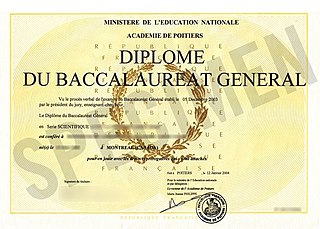References and external links
Academic grading in Europe | |
|---|---|
| Sovereign states |
|
| States with limited recognition | |
| Dependencies and other entities | |
| Academic grading |
|---|
| Africa |
| North America |
| South America |
| Asia |
| Europe |
|
| Oceania |
The Russian Federation uses a five-point academic grading system, where:
| 5 | "Excellent" (Russian пять [ˈpʲætʲ] , отлично [ɐtʲˈlʲitɕnɐ] ), denotes highest distinction and excellent knowledge of a subject |
| 4 | "Good" (Russian четыре [tɕɪˈtɨrʲɪ] , хорошо [xərɐˈʂo] ), denotes good knowledge of a subject |
| 3 | "Satisfactory" (Russian три [ˈtrʲi] , удовлетворительно [ʊdəvlʲɪtvɐˈrʲitʲɪlʲnə] ), sometimes translated as "Fair", denotes a creditable or passing grade |
| 2 | "Unsatisfactory" (Russian два [ˈdva] , неудовлетворительно, abbr. "неуд" [ˈnʲɛʊt] ), denotes limited knowledge of a subject, below average, the first level of failing |
| 1 | "Very Poor" (Russian единица, очень плохо), the lowest possible grade, denotes complete failure, and is very rarely used |
This system, with minor changes, has been in use in Russian schools since 1837. Between 1917 and 1935, the Communist government had tried to implement a radically new evaluation system with no grades at all, but it never fully took root.
Qualifiers + and – are often used to add some degree of differentiation between the grades, e.g. 4+ is better than 4 but not as good as 5–. Grading varies greatly from school to school, university to university and even teacher to teacher, and tends to be entirely subjective even for courses that lend themselves to objective marking such as mathematics and applied sciences. Even though the grades technically range from "1" to "5", "1" is not very common and is rarely given for academic reasons—in many cases a "1" is given as a result of failure to show up for an exam or to answer any questions. A "2" grade usually means that the student showed little or no knowledge in a subject.
In higher education, most subjects are graded ‘Pass/No pass’ ('Credit/No Credit') (зачёт/незачёт, pronounced "zachòt/nyezachòt"), and the rest are graded on the five-point scale. The 'Pass/No Pass' grades have no official numeric representation. When "zachòt"-type subjects are graded 'Pass/No pass' (sometimes translated as 'Credit/No credit'), this simply represents a student's good/poor knowledge of a subject. "Zachòt"-type subjects are also called "non-exams" due to lack of numerical representations. Each university applies its own standards of the level of knowledge required to pass each course. Students in Russia typically must pass all courses taken in order to graduate.

The General Certificate of Secondary Education (GCSE) is an academic qualification in a range of particular subjects, taken in England, Wales, and Northern Ireland. State schools in Scotland use the Scottish Qualifications Certificate instead. Private schools in Scotland may choose to use GCSEs from England.

Matura or its translated terms is a Latin name for the secondary school exit exam or "maturity diploma" in various European countries centered around the former Austro-Hungarian Empire, including Albania, Austria, Bosnia and Herzegovina, Bulgaria, Croatia, Czech Republic, Hungary, Italy, Kosovo, Liechtenstein, Montenegro, North Macedonia, Poland, Serbia, Slovakia, Slovenia, Switzerland and Ukraine.

Advanced Placement (AP) is a program in the United States and Canada created by the College Board. AP offers undergraduate university-level curricula and examinations to high school students. Colleges and universities in the US and elsewhere may grant placement and course credit to students who obtain qualifying scores on the examinations. The AP curriculum for each of the various subjects is created for the College Board by a panel of experts and college-level educators in that academic discipline. For a high school course to have the designation, the course must be audited by the College Board to ascertain that it satisfies the AP curriculum as specified in the Board's Course and Examination Description (CED). If the course is approved, the school may use the AP designation and the course will be publicly listed on the AP Course Ledger.

The baccalauréat, often known in France colloquially as the bac, is a French national academic qualification that students can obtain at the completion of their secondary education by meeting certain requirements. Though it has only existed in its present form as a school-leaving examination since Napoleon Bonaparte's implementation on March 17, 1808, its origins date back to the first medieval French universities. According to French law, the baccalaureate is the first academic degree, though it grants the completion of secondary education. Historically, the baccalaureate is administratively supervised by full professors at universities.
Latin honors are a system of Latin phrases used in some colleges and universities to indicate the level of distinction with which an academic degree has been earned. The system is primarily used in the United States. It is also used in some Southeastern Asian countries with European colonial history, such as Indonesia and the Philippines, and African countries such as Zambia and South Africa, although sometimes translations of these phrases are used instead of the Latin originals. The honors distinction should not be confused with the honors degrees offered in some countries, or with honorary degrees.
The High School Proficiency Assessment was a standardized test that was administered by the New Jersey Department of Education to all New Jersey public high school students in March of their junior year until 2014-2015 when it was replaced by the PARCC. Together with the New Jersey Assessment of Skills and Knowledge, which was administered in grades 3–8, the HSPA was part of a battery of tests used to assess student performance in New Jersey's public schools.
University admission or college admission is the process through which students enter tertiary education at universities and colleges. Systems vary widely from country to country, and sometimes from institution to institution.
Education in Romania is based on a free-tuition, egalitarian system. Access to free education is guaranteed by Article 32 in the Constitution of Romania. Education is regulated and enforced by the Ministry of National Education. Each step has its own form of organization and is subject to different laws and directives. Since the downfall of the communist regime, the Romanian educational system has been through several reforms.

The National College Entrance Examination (NCEE), commonly known as the gaokao, is a standardized college entrance exam held annually in Mainland China. It is required for entrance into all higher education institutions at the undergraduate level in the country. It is usually taken by students in their third and last year of senior high school.

The Sijil Pelajaran Malaysia (SPM), or the Malaysian Certificate of Education, is a national examination sat for by all fifth-form secondary school students in Malaysia. It is the equivalent of the General Certificate of Secondary Education (GCSE) of England, Wales and Northern Ireland; the Nationals 4/5 of Scotland; and the GCE Ordinary Level of the Commonwealth of Nations. It is the leaving examination of the eleventh grade of schooling.

Advanced Placement (AP) examinations are exams offered in United States by the College Board and are taken each May by students. The tests are the culmination of year-long Advanced Placement (AP) courses. AP exams have a multiple-choice section and a free-response section.
The West African Senior School Certificate Examination (WASSCE) is a type of standardized test in West Africa. Students who pass the exam receive a certificate confirming their graduation from secondary education. It is administered by the West African Examinations Council (WAEC). It is only offered to candidates residing in Anglophone West African countries. The academic school-leaving qualification awarded upon successful completion of the exams is the West African Senior School Certificate.
In Japan, each school has a different grading system. Many universities use the following set of categories:
Serbia inherited the academic grading system of the Socialist Federal Republic of Yugoslavia. The grading process uses an absolute achievement scale to determine the grade of a student.
Education in the Czech Republic includes elementary school, secondary school, and post-secondary school. For students ages two to five, there are preschools that are generally not state-funded until the year before elementary school. After preschool, parents are not charged for tuition, but they must provide, stationery, and food for their children. A number of private schools exist across the country, but these schools are largely financially inaccessible for most children. There is an ongoing national discussion regarding the introduction of tuition fees for university education.
The General Certificate of Education (GCE) Advanced Level, or A Level, is a main school leaving qualification in England, Wales, Northern Ireland, the Channel Islands and the Isle of Man. It is available as an alternative qualification in other countries.
In the United States, academic grading commonly takes on the form of five, six or seven letter grades. Traditionally, the grades are A+, A, A−, B+, B, B−, C+, C, C−, D+, D, D− and F, with A+ being the highest and F being lowest. In some cases, grades can also be numerical. Numeric-to-letter-grade conversions generally vary from system to system and between disciplines and status.

The polytechnic secondary school, officially ten-class general educational polytechnic secondary school, abbreviation POS, pronounced P-O-S, was the standard type of school in the school system of East Germany. The POS was established in 1959 to replace the hitherto existing Grundschule. The school structure was a ten-class comprehensive school without any internal or external differentiation. There was a final examination at the end of the 10th grade called Abschlußprüfung, granting the Abschlußzeugnis which allowed to continue one's education to vocational training. Students with very good achievements at school were admitted to college studies or a unique education program that combined the studies of the extended secondary school and a vocational training. Students with honors got entrance to the extended polytechnic secondary school. The general style of teaching was a rather strict and authoritative version of different, highly efficient techniques of classroom management, used long before Jacob Kounin described this concept in the USA in 1974.
A high school diploma is a diploma awarded upon graduation of high school. A high school diploma is awarded after completion of courses of studies lasting four years, typically from grade 9 to grade 12. It is the school leaving qualification in the United States and Canada.
This is a list of grading systems used by countries of the world, primarily within the fields of secondary education and university education, organized by continent with links to specifics in numerous entries.